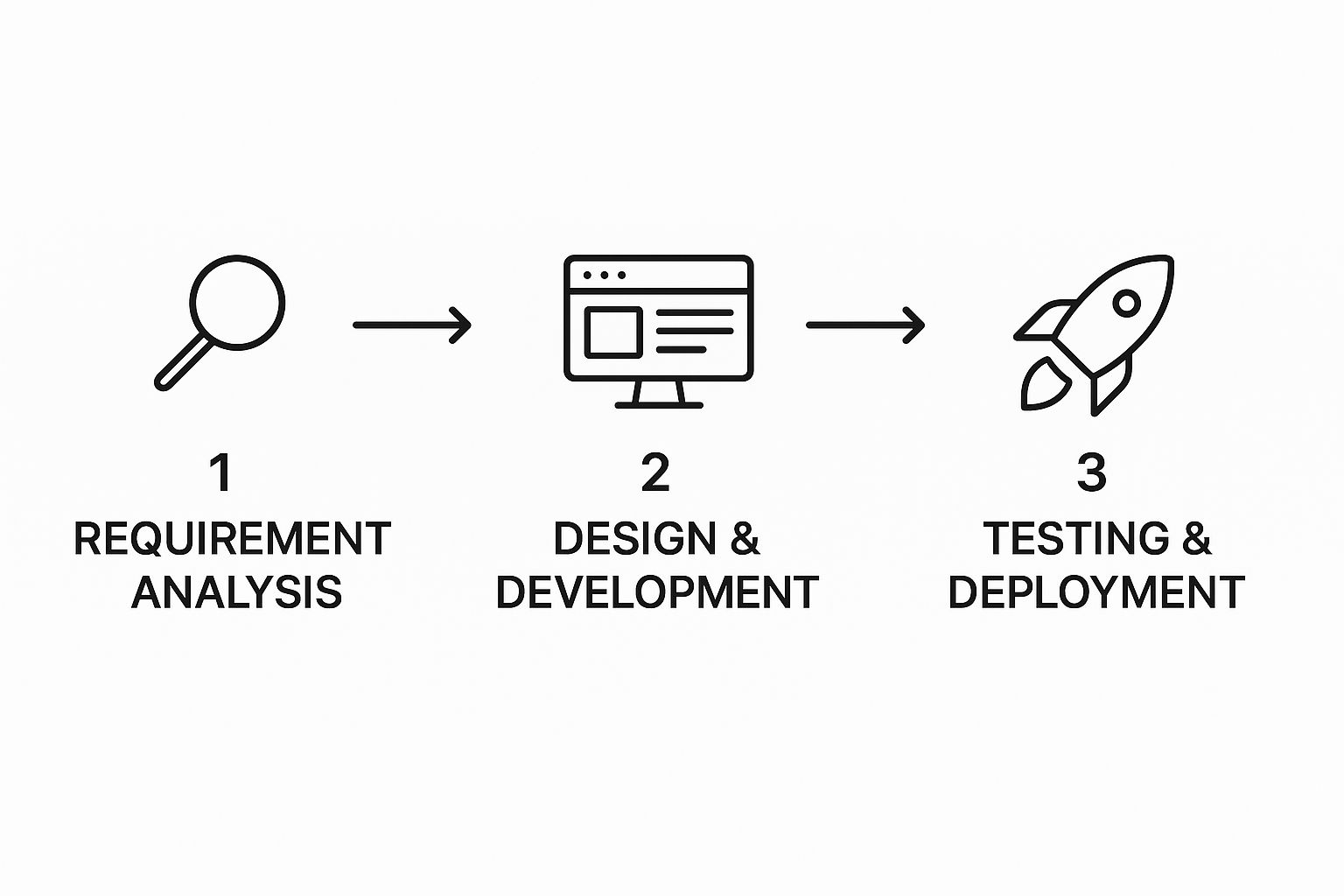What exactly is a web application development agency? In essence, they are specialist partners dedicated to the architecture, design, and deployment of interactive software that operates within a web browser. From complex e-commerce platforms to sophisticated SaaS products, these agencies provide the deep technical expertise and strategic foresight required to transform a concept into a tangible, market-ready solution.
Defining Your Project Scope Before You Hire Anyone
Before you even begin your search for an agency, the most critical work is preparatory. A vaguely defined idea is the surest path to scope creep, missed deadlines, and a final product that fails to meet user needs. With over two decades of experience building web applications, we have learned that a comprehensive project brief is the single most important document you will create. It serves as your project's North Star and the foundation for a successful partnership.
This initial planning phase is not about code; it's about achieving clarity. It is the equivalent of drafting architectural blueprints before laying a single brick. A detailed brief not only attracts higher-calibre agencies but also enables them to provide far more accurate cost estimates and realistic timelines from the outset.
Get to the Core of Your "Why" and "Who"
First and foremost, you must establish absolute clarity on the "why" behind your project. What specific problem will this web application solve? For whom are you building it? These may seem like simple questions, but the devil is in the details.
For instance, a statement like "we need an app to manage customers" is far too broad. A more effective definition would be, "we require a web application for our sales team to track leads, manage client communications, and generate monthly performance reports." The latter provides actionable detail.
Your target audience will dictate the entire user experience (UX) and feature set. Consider their technical proficiency, their objectives when using the app, and what functionality would genuinely improve their workflow or solve their problems.
Map Out Your Must-Have Features
Next, it's time to translate that core purpose into a concrete feature list. We strongly advocate for the MoSCoW method to prioritise this process effectively:
- Must-Haves: These are the non-negotiable functionalities. The application would be unviable or fail its primary purpose without them in the initial version.
- Should-Haves: These are important features, but not critical for the launch. They become the next priority if time and budget permit.
- Could-Haves: Think of these as desirable but non-essential features. They would be valuable additions in future iterations but can be postponed.
- Won't-Haves: These are features you have explicitly decided to exclude from the current version to maintain focus and manage scope.
One of the most common pitfalls we observe is the ambition to include every conceivable feature in the first version. A truly successful launch begins with a focused Minimum Viable Product (MVP) that expertly solves one or two key problems for your users.
Set a Realistic Budget from Day One
Finally, you must address the financial aspect. While the exact cost cannot be known at this stage, having a budget range in mind is crucial for filtering potential partners. It's wise to research the typical rates for web application development in the UK to ensure your expectations are grounded in market reality.
This financial transparency from the beginning ensures you engage only with a web application development agency that can operate within your financial constraints, saving considerable time and effort for all parties involved.
How to Evaluate an Agency's Portfolio and Expertise

An agency's portfolio is far more than a gallery of pleasing designs; it is tangible proof of their problem-solving capabilities. When reviewing their past work, you must adopt an analytical mindset, looking beyond the surface-level aesthetics.
Your primary objective is to differentiate between an agency that builds simple websites and one that architects robust, results-driven web applications capable of scaling with your business.
Genuine expertise lies in navigating complex technical challenges while delivering a seamless user experience (UX). A truly proficient agency will not just present a final product; they will articulate the entire project narrative—the business problem they were hired to solve and, crucially, the measurable results they achieved.
Look Beyond the Visuals
While a visually appealing portfolio is a positive indicator, it represents only one facet of an agency's competence. The real value is in understanding the complexity and functionality operating behind the user interface. Do not hesitate to delve deeply into their case studies.
Here's what you should be focusing on:
- Technical Complexity: Did they build a straightforward marketing site, or was it a multifaceted platform with features like user authentication, database management, and complex third-party API integrations? You are looking for evidence of sophisticated back-end development capabilities.
- User Experience (UX) Quality: Is the application intuitive to navigate? Does the user journey from one point to another feel logical and efficient? A strong portfolio will feature applications that are not just functional but genuinely easy and enjoyable to use.
- Tangible Business Results: Did their work generate a return on investment for the client? Look for case studies that feature hard data and KPIs, such as increased revenue, improved user engagement, or streamlined operational efficiency.
When discussing a past project, ask them to identify the specific challenges they encountered and how their team navigated them. Their response will be highly revealing of their problem-solving methodology and transparency.
We always advise prospective clients to ask, "What was your specific role in this project?" Some agencies may showcase projects where their involvement was limited, for example, to front-end design. You need to secure a partner with proven, end-to-end development experience.
Questions to Uncover True Expertise
To gain a comprehensive understanding of their capabilities, you must ask insightful questions. Your goal is to shift the conversation from what they built to how and why they made specific architectural and developmental decisions.
Here is a practical list to guide these critical conversations:
- What were the most significant technical hurdles you faced on this project, and how did you resolve them?
- How did you measure the success of this project for your client? What metrics were used?
- Can you walk me through the technology stack you chose and explain the rationale behind that choice?
- How was user feedback incorporated into the development lifecycle?
As you assess an agency's technical acumen, it is also wise to probe their understanding of search engine indexing, which is vital for your web app’s digital visibility. A strong online presence is non-negotiable in today's market. For instance, 81% of users form a negative opinion of a brand if its website or app is poorly constructed.
This is why a detailed evaluation is paramount. For further insights, our guide on how to find the right app developer for your start-up company is a valuable next step.
How to Properly Vet a Potential Web App Agency
 You have now compiled a shortlist of agencies with impressive portfolios. The real due diligence begins here. This is the vetting stage, where you must distinguish genuine strategic partners from those who merely excel at sales. With two decades of industry experience, we can affirm that a structured vetting framework is absolutely essential for selecting a reliable web application development agency.
You have now compiled a shortlist of agencies with impressive portfolios. The real due diligence begins here. This is the vetting stage, where you must distinguish genuine strategic partners from those who merely excel at sales. With two decades of industry experience, we can affirm that a structured vetting framework is absolutely essential for selecting a reliable web application development agency.
This process is not about checking boxes. It is about a deep dive into their thought processes, communication protocols, and methods for handling the inevitable challenges of a complex project. You are not just procuring code; you are investing in a partnership that will be instrumental to your product's success. The objective is to gain a completely transparent view of the working relationship before any contract is signed.
Go Beyond the Portfolio: Talk to Their Past Clients
The most valuable insights will always come from those who have already navigated this process. Do not simply request a list of references for a polite conversation. You must prepare specific questions that get to the core of the client experience.
When speaking with a past client, ask targeted, experience-based questions such as:
- "Could you describe a challenging moment in the project? How did the agency's team communicate when a deadline was at risk?"
- "How did the project manager respond to unexpected scope changes or critical feedback from your team?"
- "Was the team you were introduced to during the sales process the same team that executed the development work?"
The answers to these questions will reveal more than any polished case study. Pay close attention to descriptions of how the agency handles adversity—that is the true test of a quality partner.
A significant red flag, learned from years of observation, is an agency that restricts direct communication with their developers or project managers before a contract is signed. If they silo you with the sales team, it often indicates a disconnect between the promises made and the delivery team's capabilities or organisation.
Get Under the Bonnet of Their Process and Methodology
Any agency of merit operates on a well-defined process, not improvisation. They should be able to clearly articulate their project management methodology, whether it's Agile, Scrum, or a hybrid model. Ask them to provide a detailed walkthrough of a typical project lifecycle, from the initial discovery workshop to final deployment.
Vague, high-level answers are a major warning sign. A seasoned web application development agency has a battle-tested workflow and can explain it with clarity and confidence. They should be able to specify exactly how they manage:
- Sprint planning and reviews: How do they prioritise the development queue, and what is the cadence for demonstrating progress?
- Communication channels: What tools are used for daily communication—Slack, Microsoft Teams, etc.? What are their standard response times?
- Quality assurance: What does their testing protocol entail? Who is responsible for it, and at what stages is it implemented?
Securing this level of detail upfront mitigates the risk of unwelcome surprises after the project commences. A transparent, structured process is the bedrock of every successful web application we have ever delivered; it provides the clarity and predictability necessary for a seamless partnership.
Web Application Development Agency Vetting Checklist
To aid this process, we have developed a checklist. Use it to evaluate and compare potential agencies objectively, ensuring you cover all critical areas.
This checklist is not exhaustive, but it provides a robust, structured framework for comparing your shortlisted agencies and making a decision based on evidence, not intuition.
Decoding Proposals, Budgets, and Contracts
Receiving the first proposal from a potential web application development agency is an exciting milestone. However, this is the point at which you must transition from a visionary to an analyst. With over two decades in this industry, we've witnessed numerous projects falter due to poorly structured proposals or ambiguous contracts.
These documents are much more than price tags; they are the architectural plans for your partnership. A thorough and critical review is your primary defence against unforeseen costs, ill-defined deliverables, and unrealistic timelines. Your ability to read between the lines at this stage will be a defining factor in your project's ultimate success.
Fixed Price vs. Time and Materials
One of the first distinctions you will notice is the billing model. The two most prevalent models are Fixed Price and Time and Materials (T&M). The optimal choice depends entirely on the clarity of your project scope.
- Fixed Price: This model is most suitable for projects with a clearly defined and well-documented scope. You agree on the total cost upfront, which provides budget certainty. The main drawback is that any change, however minor, will typically require a change order and a new quote, potentially causing delays.
- Time and Materials (T&M): This model is ideal for more complex or long-term projects where requirements are expected to evolve. You pay for the actual hours worked by the development team, which affords greater flexibility. The inherent risk is the potential for budget creep if the scope is not managed with discipline.
For a deeper dive into the financial aspects, our guide on web app development costs is an excellent resource, breaking down the factors that influence the final investment.
This flow diagram illustrates the key development stages that should be clearly articulated in any professional proposal, from initial analysis through to deployment.

When these distinct phases are laid out in a proposal, it is a strong indicator that you are dealing with a structured and professional agency that follows a robust process.
What to Look for in the Contract
Consider the contract your project's safety net. Before signing, you must ensure it explicitly covers several critical areas. Ambiguous language is a significant red flag, so do not hesitate to push for absolute clarity.
Based on our extensive experience, the intellectual property clause is the single most frequently overlooked element. Your contract must state, without ambiguity, that you own 100% of the source code and all related IP upon final payment. This should be non-negotiable.
Beyond IP ownership, a robust contract will detail payment milestones tied to specific, tangible deliverables, outline the terms for post-launch support, and define a clear process for managing change requests. As you review these terms, a solid understanding Service Level Agreements (SLAs) is invaluable for setting clear expectations and ensuring accountability from your agency partner.
Mastering the Onboarding and Project Kickoff

You have signed the contract. The procurement phase is complete, and the true partnership begins. The manner in which you manage the onboarding and project kickoff will set the precedent for the entire engagement.
From our two decades of experience, we can state with certainty that a disorganized start almost invariably leads to friction, miscommunication, and missed deadlines down the line.
A formal kickoff is more than a procedural step; it is a strategic alignment session. It is your primary opportunity to ensure everyone—from your head of marketing to their lead developer—is synchronised. This is where you confirm a shared vision, a common understanding of the goals, and an agreement on the collaborative framework. It is the moment a legal document transforms into a cohesive, high-functioning team.
Setting the Stage for Success
The kickoff meeting is the centerpiece of this phase. Any professional web application development agency will arrive with a structured agenda, but it is imperative that you have your own objectives for the meeting. This is not merely a round of introductions.
Your primary goals should include:
- Confirming all key stakeholders on both sides and defining their specific roles and responsibilities. Who has sign-off authority? Who is the primary contact for technical queries?
- Reaffirming the project goals and the key performance indicators (KPIs) that will be used to measure success.
- Finalising the project roadmap and agreeing on the deliverables for the initial development sprint.
This meeting is also the ideal forum to establish your communication rhythm. Decide on the tools you'll use (e.g., Slack or Microsoft Teams), the frequency of status meetings, and the expected response times for communication. Clarifying these protocols now will prevent immense frustration later.
A critical error we consistently observe is clients failing to provide the agency with all necessary access credentials from day one. You cannot expect the team to be productive if they spend the first week requesting logins to your systems or access to brand assets.
The Importance of a Smooth Knowledge Transfer
For the agency to operate as a true extension of your team, the knowledge transfer must be as seamless as possible. This involves providing them with all the resources they need to immerse themselves in your business and fully grasp your strategic vision.
This all occurs within a fiercely competitive UK market. The web design services industry is valued at approximately £658.2 million for 2025. Despite some market contraction, demand remains robust, driven by high internet penetration. Agencies are increasingly leveraging AI to offer more efficient, personalized solutions to gain a competitive edge. Your comprehensive knowledge transfer is what enables them to apply these advanced tools effectively to your specific business challenges. You can explore more UK web design industry trends on IbisWorld.
Prepare a 'kickoff package' for your new agency partner. It should include assets such as:
- Brand Guidelines: The complete style guide, logos, fonts, and colour palettes.
- System Access: Logins for any relevant platforms like analytics, CRM, or existing hosting environments.
- Key Personnel: A directory of internal contacts and subject matter experts they can consult with directly.
Taking this proactive approach demonstrates your commitment and empowers the development team to begin delivering value immediately, fully aligned with your goals from the very first line of code.
Got Questions About Hiring an Agency? We’ve Got Answers
Even with a meticulous plan, engaging a web application development agency for the first time can feel like a significant undertaking. We understand this. Over the past two decades, we have consulted with countless business leaders and found that the same critical questions consistently arise.
Obtaining clear, expert answers is essential for moving forward with confidence. It allows you to set realistic expectations, protect your investment, and ultimately, be certain in your choice of partner. Let's address the most common queries we encounter, providing the kind of direct, experience-based insights you need.
How Much Does a Custom Web Application Cost in the UK?
This is invariably the most pressing question, and the only honest answer is: it depends entirely on the requirements. The final cost is a function of feature complexity, user interface sophistication, and the underlying technology stack.
To provide a general frame of reference, a well-defined Minimum Viable Product (MVP) incorporating core, essential features typically falls within the £20,000 to £50,000 range. For a more complex, enterprise-level system with numerous integrations and sophisticated business logic, the investment can easily exceed £100,000.
If we could offer one piece of advice from our years of experience, it would be this: view this as an investment in quality, not a simple cost. Opting for the cheapest quotation is almost always a false economy, often resulting in higher long-term costs associated with rectifying technical debt, patching security vulnerabilities, and salvaging a poor user experience that fails to deliver a return.
What Is a Typical Web App Development Timeline?
Similar to cost, the timeline is directly proportional to the project's scope and complexity. However, any well-managed project should adhere to a predictable cadence. Be wary of any agency that promises an exceptionally rapid turnaround without first investing the time to thoroughly understand your requirements.
A standard project is generally structured into several key phases:
- Discovery & Planning (2-4 weeks): This is the foundational stage where we align on goals, define the scope, and construct a detailed project roadmap.
- UX/UI Design (4-6 weeks): Our design team creates wireframes and high-fidelity mockups, mapping the entire user journey for your approval before development begins.
- Development & Implementation (12-20+ weeks): This is the most substantial phase, where our developers are focused on writing code and building the application.
- Testing & Deployment (2-3 weeks): Before launch, the application undergoes rigorous quality assurance testing to identify and resolve any bugs.
It is important to recognise these are estimates. The final schedule is heavily dependent on the project's complexity and, just as critically, on the timeliness and clarity of your feedback at each stage.
Who Owns the Intellectual Property and Source Code?
This is a non-negotiable point. There is only one correct answer to this question: you, the client, must retain 100% ownership of the intellectual property (IP) and the final source code. There are no exceptions.
Ownership of the code grants your business autonomy. It means you have the freedom to scale the application, introduce new features, or engage a different development partner in the future. It is also a tangible asset that adds significant value to your company. Ensure this is explicitly stated in your contract before signing.
What Happens After My Web Application Is Launched?
The launch is not the end of the journey; it is the beginning. Post-launch support is vital for the long-term health and success of your application. The digital landscape is constantly evolving—browsers are updated, new security threats emerge, and user needs change over time.
Any reputable agency will offer ongoing maintenance and support plans, typically structured as a monthly retainer. This service should cover essential activities:
- Resolving any emergent bugs
- Applying regular security patches
- Monitoring performance and implementing optimisations
- Managing servers and system updates
It is highly advisable to discuss a Service Level Agreement (SLA) before the project concludes. This ensures a clear plan is in place to keep your application secure, performant, and delivering value long after its initial launch.
Ready to transform your vision for a powerful web application into a market-ready reality? At Make IT Simple, we bring over two decades of experience to build scalable SaaS platforms that drive real growth. Book a free consultation today and let's discuss how we can build your success story together.


